Remodeling a bathroom is one of the costliest home improvement projects. According to HomeAdvisor, the average bathroom remodel costs around $10,911 as of April 2020. A high-end remodel for a large or master bathroom could run you $25,000 or more. However, in our guide “8 Tips for Cutting Costs on a Bathroom Remodel or Renovation,” we share practical advice to help you refresh your bathroom for considerably less.
But if those numbers are too much for your budget, that doesn’t mean you have to live with your dingy, dated bathroom forever. There are ways to refresh a bathroom for considerably less. According to This Old House, homeowners have redone their bathrooms for $6,000, $4,000, $2,000, and even less than $1,000.
I also know from personal experience it’s possible to renovate a bathroom on a budget. In 2011, my husband and I redid our guest bath for less than $900, including a new sink, toilet, vanity, faucets, light fixtures, floor tiles, paint, and accessories. With a bit of ingenuity and effort, other homeowners can do the same.
Cutting Costs to Save on a Bathroom Remodel
Our budget bath remodel and those featured on sites like This Old House and Apartment Therapy all have one thing in common: The homeowners looked for ways to save money anywhere they could. We didn’t necessarily use the same techniques, but we all relied on numerous money-saving strategies to get the job done for less.
The 8 tips for cutting costs on a bathroom remodel or renovation that helped us and other homeowners save money on our bathroom renovations fall into several major categories.
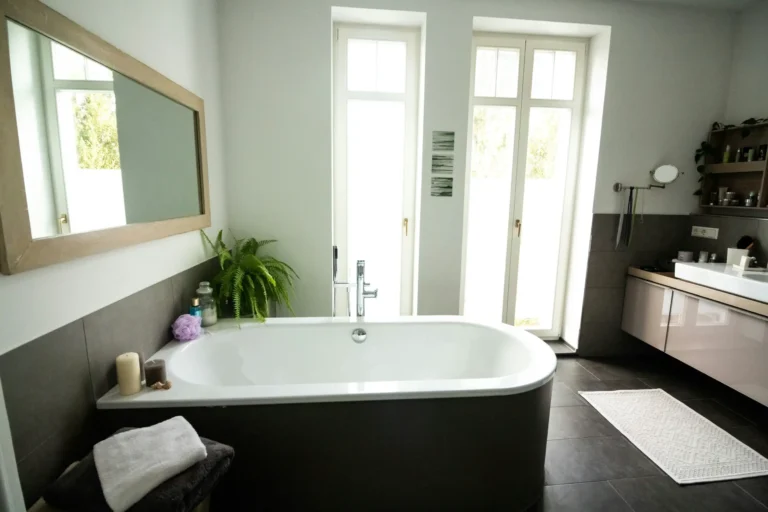
1. Plan Ahead
During any remodeling project, one of the costliest things you can do is change your plans halfway through. At best, it delays the project while you return materials and buy new ones. At worst, it requires you to pay contractors to redo work they’ve already done.
Sometimes, in-progress changes are unavoidable, such as when you cut into a wall and discover a leak. But in most cases, you can avoid them by thinking things through carefully before anyone picks up a tool. It’s much cheaper to know in advance you don’t want the toilet to be the first thing guests see when they open the door than figure it out once you’ve already installed it.
That’s why the first step in any bathroom remodel is planning. Before you buy anything or hire anyone, think about what you want from your new bathroom. What is it about the room that doesn’t work for you now, and how can you fix it? List everything you want your remodeled bath to have, and then sort that list into must-haves and nice-to-haves.
Take your time figuring out your wants and needs. If you can’t figure out the best way to accomplish all your goals, you can hire a bathroom designer for a consultation. According to Hunker, this service typically costs $200 to $400, and it can help you avoid mistakes that cost money to fix later.
In addition to thinking about the layout, spend time comparing options for visual elements like tile, plumbing fixtures, and light fixtures. That way, when you’re finally ready to get started, you know exactly where to shop to find what you want at the best price. Buying in a hurry often means paying extra or settling for something that isn’t ideal.
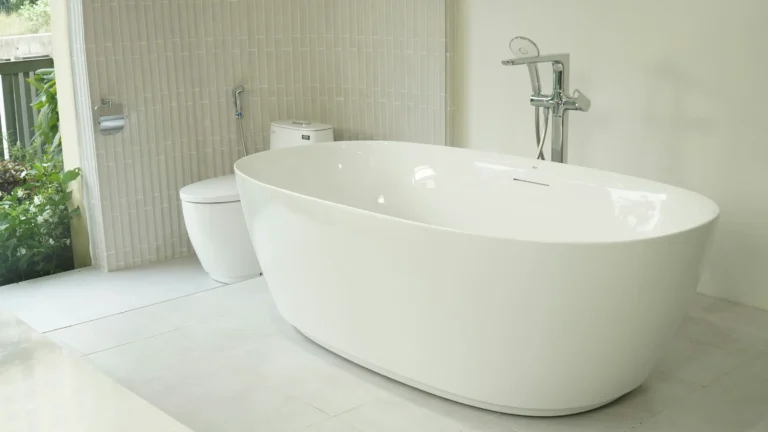
2. Keep the Footprint Unchanged To Cut Down on Costs
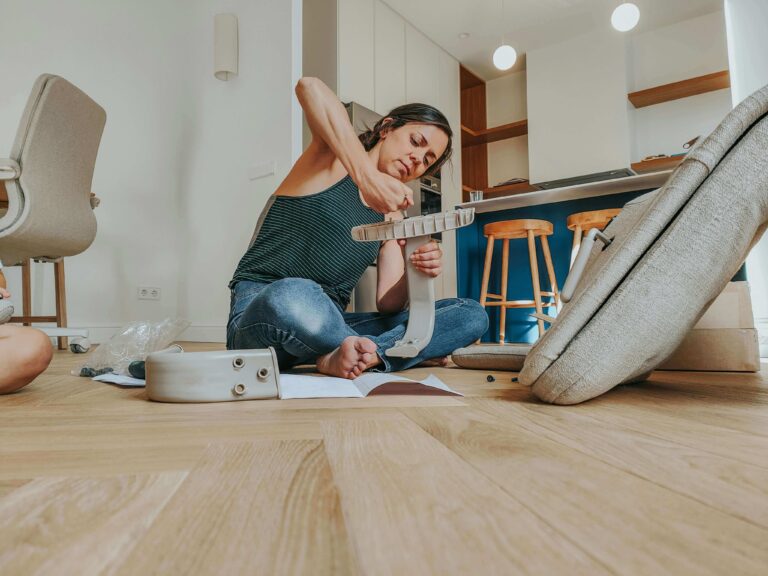
One of the best ways to save on a bathroom remodel is not to remodel at all. People often use the terms bathroom remodeling and bathroom renovation interchangeably, but they’re not the same thing.
A remodeling job involves making significant changes to the room’s footprint, or its size, shape, and structure. It can include making changes to any or all of these:
- The room’s foundation
- Walls, especially load-bearing walls
- Plumbing lines
- Locations of plumbing fixtures, such as the sink and toilet
- Electrical wiring
Renovation means freshening up the bathroom’s look — tile, wall color, flooring, lighting — while leaving its basic layout unchanged.
Changing the footprint adds time and labor costs to the project. It also usually involves getting building permits, which are a significant expense. The cheapest bathroom redos are usually renovations rather than full remodels.
There are lots of ways to change the look of a bathroom without changing the footprint. You can change the fixtures, walls, flooring, lighting, and accessories without moving anything. You can even make a small bathroom feel larger by adding a lighter paint color, a clear glass shower door, or a skylight to let in more natural light.
If you absolutely have to add square footage to your bathroom or change the arrangement of fixtures, keep the changes to a minimum. That way, you limit the number of labor hours you need from expensive contractors like plumbers.
3. Do the Work Yourself To Minimize Expenses on a Master Bath Remodel or Renovation
According to HomeAdvisor, roughly half the cost of bathroom remodeling is labor costs. Homeowners spend an average of $65 per hour paying contractors, including carpenters, plumbers, electricians, drywallers, and floor tilers. Thus, the more of your bathroom remodel you can DIY instead of hiring a contractor, the more you can save.
But DIY is only a money-saver if you have the necessary skills. Some jobs, like moving plumbing lines, are best left to the pros. If you try to do them yourself with no training beyond a five-minute YouTube video, you could cause a flood. The damage that does will cost a lot more than hiring a plumber in the first place.
However, most homeowners can handle at least some of the jobs in a bathroom renovation. Depending on your skill level, you could tackle jobs like:
- Demolition (pulling out old wallboard, flooring, and cabinetry)
- Painting
- Tiling
- Replacing faucets and showerheads
- Adding accessories like towel racks
- Installing bathroom lights
- Installing new plumbing fixtures
Homeowners with a little DIY experience can take on more ambitious DIY projects. For instance, when we couldn’t find a stock vanity cabinet we liked, my husband built one from plywood and beadboard.
A Texas homeowner profiled by This Old House made almost all the materials for his powder room renovation. He poured his own concrete countertops, built new doors and drawer fronts for the vanity, and even welded a new frame for the mirror. Another couple in Missouri built their own cabinetry, made custom light fixtures, and enameled an old bathtub.
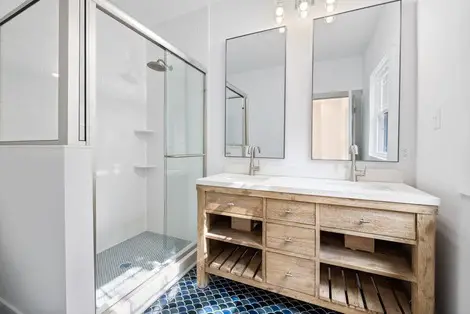
4. Reuse Existing Pieces for Cutting Costs on a Bathroom Remodel or Renovation
Doing the work yourself is the primary way to save on labor costs. But when it comes to materials, there are lots of different ways to save. One of the most effective is to refurbish the pieces you already have rather than buying new ones.
With a little work, you can change the look of nearly any piece in a bathroom, such as:
- Bathtubs: One homeowner was able to salvage an old, rust-stained tub by having it cleaned professionally. You can also fix surface damage to porcelain, cast iron, and fiberglass tubs by refinishing them. A DIY tub refinishing kit costs around $80.
- Shower Enclosures: A tiled shower enclosure can look like new if you clean both tile and grout thoroughly. The grout may also need some patching in worn areas. To give it a fresher look, you can stain white grout a darker color. If you have acrylic or fiberglass shower walls, you can patch dented or cracked spots. A repair kit costs under $20.
- Sinks: You can dramatically change the look of a sink by replacing the faucet. If the porcelain is cracked, you can repair it with either a porcelain repair kit or a two-part surface repair epoxy. Both cost less than $15.
- Toilets: Rather than paying $100 or more for a new toilet, give yours a new look by replacing the toilet seat and lid for $30 or less. To add a touch of elegance, opt for a wooden toilet seat or soft-close model that doesn’t slam shut.
- Cabinetry: You can save hundreds of dollars on cabinets by painting or refinishing the pieces you already have. If the doors are too damaged, replace them while keeping the cabinet boxes. According to HomeAdvisor, that typically costs $30 to $100 per door, not counting labor.
- Floors: Like shower enclosures, you can refurbish tile floors by cleaning them thoroughly and replacing or staining the grout. If you have wood floors, you can have them professionally refinished for $3 to $8 per square foot, according to HomeAdvisor.
- Walls: The cheapest way to change the look of your walls is to repaint them in a different color. If you have tile walls you don’t like, you can install new wood panels or beadboard wainscotting over the tile. At around $20 per beadboard panel, that’s cheaper than tearing it out and replacing it, and it lets you switch back to tile later if you want.
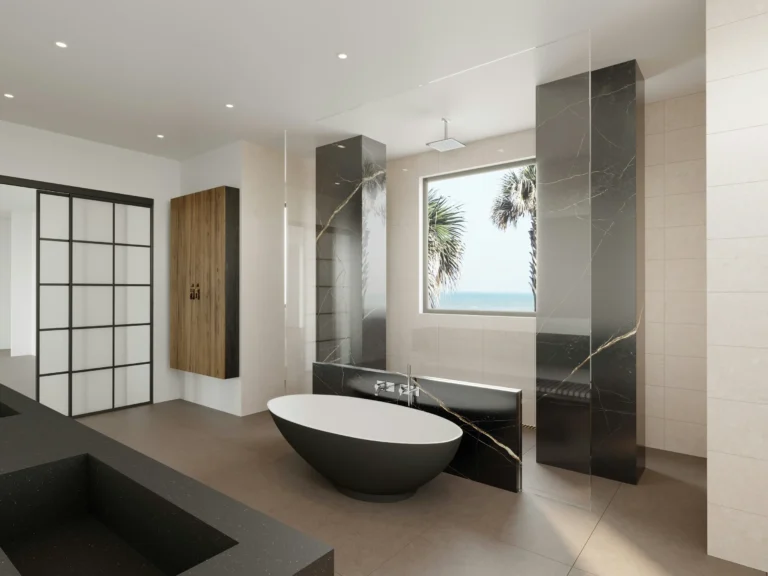
5. Use Paint Creatively
Just changing the paint color in your bathroom can make a surprisingly significant difference to its overall look. But you can do a lot more with paint than just roll it over a wall. Creative homeowners have used it for:
- Textured Effects. You can give a wall a textured look by using two different colors. Start by giving the whole wall a base coat in one color. Then use a textured tool, such as a sponge, rag, or comb, to apply the second coat. We used a sponging-off technique in our bathroom to create a look similar to stucco.
- Faux Wallpaper. Paint can give you the look of wallpaper with less money and effort. For instance, you can make your bathroom look larger by painting it with broad, horizontal stripes. Or use a stencil to create a pattern on the wall.
- Faux Tile. You can also use paint and stencils on a wood or concrete floor to create the look of tile for less. Just use sturdy porch paint and three coats of polyurethane to stand up to the humid environment.
- Real Tile. According to Sherman Williams, it’s even possible to paint over real tile. Clean the bathroom wall tile thoroughly, scuff it with sandpaper, and apply a water-based acrylic primer. Top it with a durable latex or urethane paint, and you have “new” tile without the hassle and expense of replacing the old tile.
- Refinishing Fixtures. You can use enamel paint to salvage an old bathtub or spray paint and lacquer to change the finish of a sink faucet.
6. Use Cheaper Materials
There are limits to what you can do with paint. But there are many other ways to substitute cheaper materials for pricier ones and get the look you want for less. To stretch your dollars when renovating a bathroom, splurge on just one or two high-impact items, such as countertops or a clawfoot tub, and choose cheaper alternatives for everything else.
There are cost-effective alternatives for nearly every part of a bathroom remodel.
7. Walls
Tile costs a lot more than paint or paneling. To keep your costs down, limit your use of tile on the walls as much as possible. Use it only in areas that get wet regularly, such as the tub or shower enclosure.
For the rest of your walls, painted drywall is the cheapest alternative. However, wood panels can create a more interesting look at a lower price than tile.
8. Flooring
Bathroom flooring options fall into three price ranges. The cheapest options are laminate and vinyl, which can cost $1 or less per square foot. Wood and ceramic tile are midrange alternatives, and stone tile is the priciest flooring of all.
If you crave the look of stone, it’s often possible to get it with a cheaper ceramic. One inexpensive bathroom remodel covered by This Old House includes slate-look ceramic tiles that cost only $85 for the whole room.
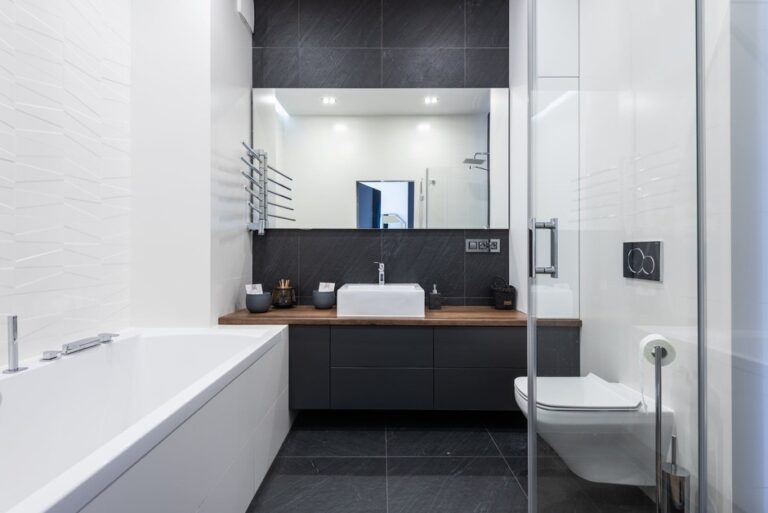
9. Tub and Shower Enclosures
If you can’t refurbish your existing shower walls, the cheapest way to replace them is with large panels of fiberglass or acrylic. These cost as little as $100 each and are quick to install.
However, if you prefer the look of a tiled wall, go for porcelain or ceramic tile rather than pricier glass or stone. You can also save time and money by choosing larger tiles. These require less grouting, so you save on labor costs.
If you’ve fallen in love with a fancy designer tile, search for a cheaper look-alike. Alternatively, use the fancy tile as an accent, filling in most of the wall with a more affordable tile. Not only will you save money, but the expensive tile will stand out more.
As for the front of the tub or shower enclosure, a shower curtain is cheaper than a glass door and easier to install. It’s also easy to clean — just take it down and toss it in the washer. And you can easily swap it out any time you want to change the look of the bathroom.
10. Tub and Shower Hardware
If you need to replace your bath or shower handles, spout, and showerhead, it’s probably cheapest to buy them as a set. These sets, called trim kits, can cost as little as $100 to $200 each.
However, if the handles are still in good shape, it could be cheaper to keep them and replace the shower head only. A good shower head contributes a lot more to a satisfying shower than nice-looking handles. Many top-rated shower heads cost less than $50.
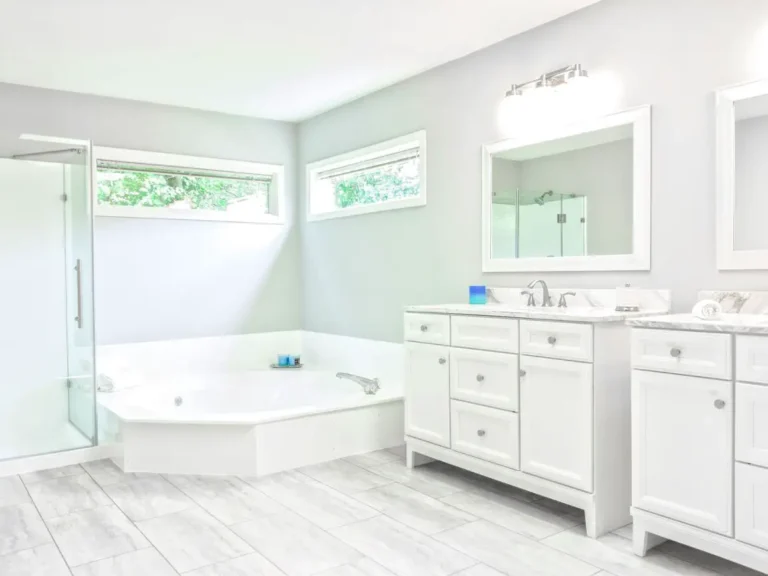
11. Cabinetry
The cheapest type of storage for the bathroom is open shelving. You can create wall-mounted shelves with nothing but a plank of wood and some wall brackets. These can go on any empty wall, including behind the toilet, to use all the space in the room.
If you want to keep your bath supplies behind closed doors, stock cabinets are cheaper than custom cabinetry. You can also compromise between the two by choosing semi-custom, ready-to-assemble cabinets. This product lets you configure size and features to fit your space. But the more options you add, the more it costs.
As for cabinet materials, laminate or thermofoil cabinets are cheap and easy to clean. However, they can warp over time, so they may not save you money in the long run. You can save on wood cabinets by choosing pine, maple, oak, or alder over pricier mahogany, cherry, or walnut. If you prefer darker wood, you can buy cheaper pieces and stain them.
The style of the cabinets also matters. You save the most by choosing flat doors rather than doors with raised panels and drawers rather than pull out cabinets. Shop around to find brands of both cabinets and hardware that give you the look you want at the lowest price.
One inexpensive and trendy option for a vanity cabinet is to repurpose an old dresser. You can find dressers through secondhand sources like garage sales and Craigslist for much less than you’d pay for a store-bought vanity cabinet
12. Toilets
Considering they all do the same job, there’s a surprising range in the price of toilets. As a rule, round toilets are cheaper than those with an elongated bowl, and two-piece toilets cost less than one-piece ones. Two-piece toilets take up more room and are a little harder to install, but they’re easier and cheaper to repair if they break.
One type of toilet to avoid is a wall-hung model with the tank recessed into the wall. This design saves space, but it’s harder to install and repair, costing you money.
It’s also worth considering water-saving toilets. These don’t cost significantly more upfront, and they save you money on your water bill over their lifetime..
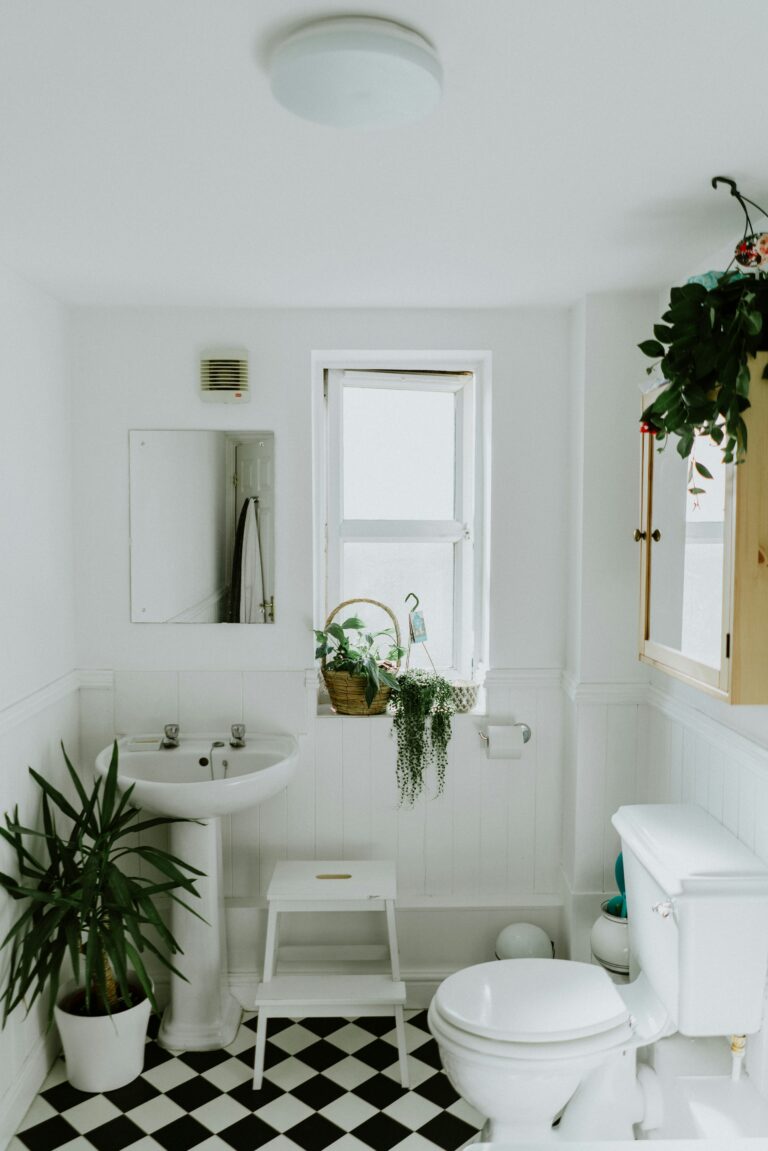
13. Shop Secondhand for Cost Savings on a Bathroom Renovation or Remodel
Another way to save on materials for your bathroom renovation is to buy them secondhand. The Missouri couple who created a luxury master bathroom on a $6,000 budget got nearly everything used, including a salvaged clawfoot tub, discarded cabinet doors from a kitchen and bath showroom, a scavenged marble scrap for a countertop, and a yard sale mirror.
Shopping secondhand isn’t as easy as going into a store and putting things in a cart. It pays to start early to ensure you have plenty of time to find what you want. While you’re still in the planning phase of your remodel, start checking secondhand sites for items that match your wish list.
Places to find secondhand materials include
- Reuse Centers. If you have a reuse center in your area, you can find everything you need for your bathroom remodeling project there, from tile to light fixtures. When we redid our bathroom, we hit the Habitat for Humanity ReStore and found Italian ceramic tile for under $3 per square foot and a cultured marble sink and vanity top for $30.
- eBay. You can find nearly anything on eBay, including bath supplies. The Texas homeowner who redid a powder room for $705 bought a sink, faucet, and light fixtures from online auctions for $390 total. Just remember to factor in shipping costs when buying online, especially since bath items can be heavy.
- Craigslist. Check the for-sale section of your local Craigslist site for bath bargains. A quick search of the listings on my local group turned up plumbing fixtures, countertops, cabinetry, light fixtures, and even a ventilation fan.
- Nextdoor. Nextdoor is a social media group designed to help neighbors connect. Members can buy and sell unwanted goods through the Finds section. Listings for bath pieces aren’t that common, but it’s worth a look.
- Freecycle. Through the Freecycle Network, members give away unwanted items to people in their area at no cost. Check your local group for free stuff you could use as part of your bathroom remodel.
- Flea Markets. Check out flea markets for antique pieces for your bath remodel, such as a clawfoot tub or an old-fashioned light fixture. Just don’t buy anything you can’t haul home since there’s no delivery service.
- Antique Stores. Antique stores are another excellent source of vintage furniture and materials. But they’re likely to charge higher prices than other resellers.
- Yard Sales. Shopping at garage sales is a hit-or-miss proposition. You can’t always find what you want, but when you do, the prices are terrific. The Missouri couple with the $6,000 master bath renovation made several affordable finds at yard sales, including a $35 etched glass mirror and a marble slab for just $1.
Your Own Home. Don’t hesitate to reuse materials left over from other projects in your bathroom renovation. Several homeowners profiled by This Old House reused leftover materials, including paint and beadboard.

14. Look for Bargains to Save on Bathroom Remodel or Renovation
If you can’t get all the materials for your bathroom secondhand, you can save by finding them on sale. For instance, one couple from New York found a cast-iron bathtub on sale for $350. Most new cast-iron tubs cost $1,000 or more.
The holiday season is an excellent time to find remodeling materials on sale. According to CabinetNow, the best seasonal sales on cabinetry occur on Black Friday and in the weeks before Christmas.
However, shopping sales isn’t the only way to find deals on new materials. One of the best ways to find bargains is to shop around. Comparison-shopping websites and tools can help you find the best prices when shopping online. Other money-saving browser extensions can help you find coupon codes to cut costs still more.
Also, don’t overlook discount sites like Overstock.com. This site offers everything you need for a bathroom renovation, from tubs to tile, at prices well below retail.
If you find reasonable prices for several products in one store, but its prices on other things you need are higher, find out if the store offers a price-match guarantee. If it does, you could get the best prices on everything you need at once without having to visit multiple stores.
Finally, if you buy a lot of materials from one place, ask about volume discounts. Home centers like Home Depot offer discounts on bulk sales. It’s primarily for professional contractors, but it can’t hurt to ask.
Final Word
A bathroom remodel doesn’t have to cost a small fortune. There’s no doubt that some upgrades, like a fully tiled walk-in shower or expanding the square footage of your master bath, can run into the tens of thousands of dollars. But with good planning and a little creativity, you can make your bathroom into a luxurious retreat on a much smaller budget.
This article is accredited to Amy Livingston. Date May 24, 2023. MoneyCrasers.com. www.moneycrashers.com/bathroom-design-remodeling-ideas-budget
